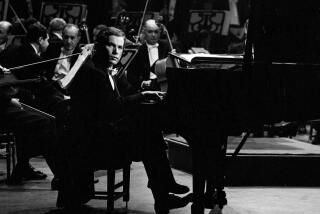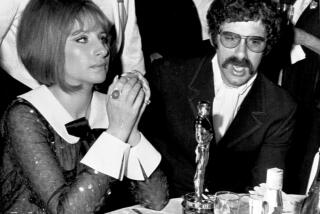Stephen Gould, 60; Leading Evolutionary Biologist Was Called ‘Latter-Day Darwin’
- Share via
Stephen Jay Gould, an influential evolutionary biologist, prolific essayist and passionate New York Yankees fan, died Monday of cancer at his home in New York City.
Unfailingly witty, frequently controversial and occasionally combative, Gould, 60, was one of the best-known scientists of his generation. For many, he became the public face of science--a quick sketch of heavy-lidded eyes and a knowing half-smile separated by a thick, brush mustache.
A professor of zoology at Harvard University and biology at New York University, Gould used his academic bully pulpit to champion understanding of science in issues large and small. He was a best-selling author whose 22 books most often sought to make complex debates about geology, paleontology and evolutionary biology accessible to as many as possible.
“The Mismeasure of Man,” a critical study of intelligence testing, won the National Book Critics Award in 1982.
A 1989 book, “Wonderful Life: The Burgess Shale and the Nature of History,” used the example of the Burgess Shale, a small fossil area in British Columbia, to support his theory that humans are little more than an accident of nature. It became a national bestseller within weeks of its release and was a finalist for the Pulitzer Prize in 1991.
And this spring, Harvard University Press published what almost certainly was the culmination of his life’s scholarly work--a 1,433-page tome that Gould labored on for 20 years that seeks nothing less than to reformulate Darwin’s theory of evolution.
In scores of essays, Gould expounded authoritatively on a variety of topics, including religion, the fallacies of racial biology, Gilbert and Sullivan, and the demise of the .400 hitter. “This View of Life,” his monthly column in Natural History magazine for which he wrote 300 essays, won the National Magazine Award for Essays and Criticism in 1980.
“Steve Gould always seemed larger than life. His ideas, powerful and commonly controversial, inspired PhD theses for three decades,” said Harvard colleague Andrew Knoll, a natural history professor in the university’s department of molecular and cellular biology.
“I’m not sure he ever thought a small thought in his life.”
Gould was best known in scientific circles for the theory of punctuated equilibrium that he proposed with his colleague Niles Eldredge of the American Museum of Natural History in 1972.
In a series of controversial papers, Gould and Eldredge took issue with the Darwinian view that all life evolved slowly and incrementally over a long stretch of time from simple, common ancestral forms. Instead, using examples from the fossil record, they suggested that species experience long periods of slow and gradual evolution that may be interrupted by the abrupt emergence of new forms--punctuated rather than gradual change.
“Gradualism is more a product of Western thought than a fact of nature,” Gould wrote.
“He really changed the field of paleontology from the stamp-collecting type of science where you just catalog fossils,” said Michael Shermer, director of the Skeptic Society, an organization that Gould helped start that aimed to rebut pseudoscience.
The most dramatic piece of evidence suggesting that other forces contribute to evolutionary change, Gould would often say, was the discovery that the extinction of the dinosaurs was caused by a giant meteor striking the Earth, resulting in global dust clouds that interrupted environmental cycles and caused many life forms to die out.
Even as he championed Darwin, however, Gould thought that the theory of evolution left something to be desired.
With characteristic panache, Gould wrote in his recently published book that “nothing of Darwin’s central logic has faded or fully capsized, but his theory has been transformed, along his original lines, into something far different, far richer, and far more adequate to guide our understanding of nature.”
When Gould was first diagnosed with cancer in 1982, he believed that he had “almost zero chance of finishing” the book. He beat back the disease with surgery and chemotherapy.
“Stephen Jay Gould was a giant in his field,” said National Science Foundation Director Rita Colwell. “He was sort of a latter-day Darwin. He put together massive amounts of material in a way that relationships were pulled out that weren’t obvious” unless one had a mind of equal caliber.
Although Gould was open to new ideas, she said, “he was a prickly sort of fellow. He didn’t tolerate shoddy science.”
Indeed, Gould was for decades at the center of debates over the theory of evolution. He was, in particular, a fierce public opponent of creationism.
“The rise of creationism,” he wrote in a 1981 essay, “is politics, pure and simple.”
He attracted many critics over the years. Some accused Gould, the son of a Marxist, of having an underlying political agenda. They argued that Gould embraced the idea of punctuated equilibrium only because Marxism requires revolutionary change--a charge that Gould always called absurd.
Some critics, such as pioneering British evolutionist John Maynard Smith, writing in the New York Review of Books, suggested that Gould was simply foolish, “a man whose ideas are so confused as to be hardly worth bothering with.”
Still others dismissed the sometimes arrogant Gould as a simple-minded popularizer of science. Gould turned such attacks into compliments.
“Anything, even the conceptually most complex material, can be written for general audiences without any dumbing down,” he said in a recent interview in Mother Jones magazine. “This goes back to Galileo, who wrote his great books as dialogues in Italian, not as treatises in Latin. And to Darwin, who wrote ‘The Origin of Species’ for general readers.... So what I’m doing is part of a great humanistic tradition.”
Gould began as an enfant terrible of paleontology and ended his life as a senior statesman of science. At his death, he had just completed a term as president of the American Assn. for the Advancement of Science, the world’s largest general scientific society.
Born in New York City on Sept. 10, 1941, Gould was always a Yankees fan, especially enamored of Joe DiMaggio.
But it was not until he turned 5 that a visit to the American Museum of Natural History with his father kindled his interest in science. The young Gould was riveted by his first glimpse of the reconstructed skeleton of a Tyrannosaurus rex.
“As we stood in front of the beast,” he wrote in his essay “The Telltale Wishbone,” “a man sneezed; I gulped and prepared to utter my Shema Yisrael. But the great animal stood immobile in all its bony grandeur, and as we left, I announced that I would be a paleontologist when I grew up.”
His parents helped him look for dinosaur bones and marine fossils.
By age 11 he had read G.G. Simpson’s “The Meaning of Evolution,” and Charles Darwin had become his hero. Though his high school curriculum gave scarcely a nod to the topic--the teaching of evolution in most American schools had been in disfavor since the Scopes trial of 1925--Gould found it so exciting that he studied it on his own.
He credited his dedicated teachers at Antioch College, where he earned a bachelor’s degree in 1963, with developing his sense of himself as a scientist and teacher.
He went on to Columbia University, where he wrote his doctoral dissertation on the fossil land snails of Bermuda.
He earned a doctoral degree in paleontology in 1967 and became an assistant professor of geology at Harvard, advancing to associate professor in 1971 and professor in 1973. He became one of the faculty’s superstars, leading hugely popular undergraduate courses in geology, biology and the history of science.
Although his cancer was in remission for many years, in late February 2000, doctors discovered several tumors in his brain and lungs and on his liver, Shermer said. Gould recovered from brain surgery on April 1 to return to his course at Harvard on April 5. But while preparing for lung surgery, doctors decided that the cancer had spread too far.
Gould returned to New York City on May 13, where he was born, and entered a hospital.
“He always said he was a New York boy, born and bred,” Shermer said. “He was always a visitor in Boston.”
The scientist is survived by his wife, sculptor Rhonda Roland Shearer; his mother, Eleanor Gould; his first wife, Deborah Lee; and their two sons, Ethan and Jesse.
*
Times staff writer Liz Kay contributed to this report.
More to Read
Sign up for Essential California
The most important California stories and recommendations in your inbox every morning.
You may occasionally receive promotional content from the Los Angeles Times.











